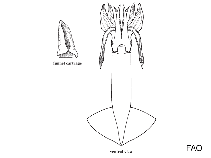Ornithoteuthis antillarum Adam, 1957
Bird squid| Native range | All suitable habitat | Point map | Year 2050 |

|
| This map was computer-generated and has not yet been reviewed. |
| Ornithoteuthis antillarum AquaMaps Data sources: GBIF OBIS |
Upload your photos
Google image | No image available for this species;
drawing shows typical species in Ommastrephidae.
Google image | No image available for this species;
drawing shows typical species in Ommastrephidae.
Classification / Names ชื่อสามัญ | ชื่อพ้อง | CoL | ITIS | WoRMS
Cephalopoda | Oegopsida | Ommastrephidae | Ommastrephinae
Environment: milieu / climate zone / ระดับความลึก / distribution range นิเวศวิทยา
กลุ่มสัตว์หน้าดิน,กลุ่มสัตว์พื้นท้องน้ำ; ระดับความลึก 0 - 1200 m (อ้างอิง 417). Tropical; 41°N - 9°S, 95°W - 11°E (อ้างอิง 275)
Distribution ประเทศต่างๆ | พื้นที่จำแนกตาม FAO | ระบบนิเวศหลายระบบ | การปรากฏขึ้น,การเกิดขึ้น,พบ | การแนะนำ
Atlantic Ocean: from Straits of Gibraltar to western Africa and the Caribbean. Circumtropical.
Length at first maturity / ขนาด / Weight / Age
วัยเจริญพันธุ์: Lm ? range ? - ? cm Max length : 30.0 cm ML เพศผู้/กระเทย; (อ้างอิง 104052)
Caught by squid jigs, dipnets, bottom trawls and midwater trawls. Maximum depth from Ref. 83938. Neritic, oceanic (Ref. 91956). Exhibits diel vertical movements (Ref. 275).
Life cycle and mating behavior วัยเจริญพันธุ์ | การสืบพันธุ์ | การวางไข่ | Eggs | ความดกของไข่ | Larvae
Members of the class Cephalopoda are gonochoric. Male and female adults usually die shortly after spawning and brooding, respectively. Mating behavior: Males perform various displays to attract potential females for copulation. During copulation, male grasp the female and inserts the hectocotylus into the female's mantle cavity where fertilization usually occurs. Life cycle: Embryos hatch into planktonic stage and live for some time before they grow larger and take up a benthic existence as adults.
Main reference
อ้างอิง | ผู้ประสานงาน | ผู้ร่วมมือ
Schneider, W. 1990. (อ้างอิง 417)
IUCN Red List Status
(อ้างอิง 130435: Version 2024-2)
Least Concern (LC) ; Date assessed: 10 May 2010
CITES status (อ้างอิง 108899)
Not Evaluated
CMS (อ้างอิง 116361)
Not Evaluated
Threat to humans
Human uses
การประมง: ไม่มีผลประโยชน์
| FishSource |
เครื่องมือ
ข้อมูลเพิ่มเติม
นิเวศวิทยาเขตร้อน
นิเวศวิทยา
Population dynamics
การเจริญเติบโต
Max. ages / sizes
Length-weight rel.
Length-length rel.
Length-frequencies
Mass conversion
การทดแทนที่
อุดมสมบรูณ์
Max. ages / sizes
Length-weight rel.
Length-length rel.
Length-frequencies
Mass conversion
การทดแทนที่
อุดมสมบรูณ์
Life cycle
Distribution
Human Related
Aquaculture profiles
Stamps, coins, misc.
Stamps, coins, misc.
Outreach
Taxonomy
อ้างอิง
แหล่งที่มาจากอินเตอร์เน็ต
BHL | BOLD Systems | CISTI | DiscoverLife | FAO(Publication : search) | Fishipedia | GenBank (genome, nucleotide) | GloBI | Gomexsi | Google Books | Google Scholar | Google | PubMed | แผนภูมิชีวิตแบบต้นไม้ | Wikipedia (Go, ค้นหา) | บันทึกทางด้านสัตววิทยา
Estimates based on models
Preferred temperature
(Ref. 115969): 8.6 - 20.5, mean 13.5 (based on 243 cells).



